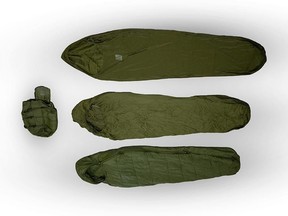In a statement to the National Post, the Department of National Defence said it has already taken action
Article content
New sleeping bags for the Canadian Army — that came with a price tag of more than $34 million — cannot withstand harsh winter weather, according to an internal report.
The General Purpose Sleeping Bag System (GPSBS) was created with the intention of keeping “soldiers warm and healthy in all kinds of weather,” according to a news release by the Canadian Army in February 2023.
Advertisement 2
Article content
“It’s about making sure we have everything the soldier needs to be able to perform in Iraq in the summer all the way to the high Arctic in the winter,” said member of the GPSBS project team Alexandre Legault, adding that an add-on component for extreme cold was “being explored.”
However, a newly surfaced report obtained by CBC News revealed that the GPSBS was no match for the climate in Ram Falls Provincial Park in Alberta in November 2023, per the publication.
Soldiers who used the sleeping bags there during deployment said there were “several critical issues” that were “related to lack of warmth with the new GPSBS,” according to the briefing note, CBC reported.
The note written in December 2023 said that the soldiers from the 3rd Battalion, Princess Patricia’s Canadian Light Infantry (3 PPCLI) used the inner and out shells of the sleeping bags in tents that were heated by stoves. But they were still cold, CBC said. The sleeping bags were not suitable “for typical Canadian winter conditions nor the extreme cold of Alaska,” per the note.
Arctic military affairs expert and University of Calgary professor Rob Huebert was critical of the GPSBS.
Article content
Advertisement 3
Article content
“I wonder if they should have just gone to Canadian Tire,” he told CBC.
Military has addressed sleeping bag issue, spokesperson tells National Post
In a statement to the National Post, the Department of National Defence said it has already taken action.
“After initial issue, a questionnaire was disseminated to end users to assess interoperability, ruggedness, comfort, adjustability, reliability, and operational, effectiveness,” National Defence spokesperson Kened Sadiku said over email on Friday.
“Feedback from 3PPCLI indicated that the system lacked adequate thermal protection when used with only a bivy in austere, mid-winter conditions.”
According to the department, those soldiers were given additional supplies like thermal blankets for “units operating in extreme environments.” An investigation officer was sent to interview 3 PPCLI soldiers.
“Unsatisfactory Condition Reports were logged, and this data will be used to inform future initiatives,” said Sadiku.
Prior to the issues with the GPSBS, the army was working on a sleeping bag for extreme cold weather — the Extreme Cold Weather Sleeping Bag system (ECWSBS) — “ensuring coverage across all climatic conditions, including the Arctic.” The GPSBS is intended for “sub-arctic conditions” whereas the ECWSBS, which is in progress, “is designed for Arctic conditions,” Sadiku said.
Advertisement 4
Article content
The GPSBS remains a core component of the Canadian Armed Forces’ sleeping system and is expected to stay in service for many years, he said.
The value of the contract for the GPSBS is $34,824,728.23, he added.
It was not immediately clear whether or not development for the ECWSBS was included in that price, or if it would be an additional cost.
Canada’s renewed focus on the Arctic
There has been a renewed push to protect the arctic by the Trudeau government.
In April, Prime Minister Justin Trudeau revealed a new policy, Our North, Strong and Free: A Renewed Vision for Canada’s Defence, at the Canadian Forces Base in Trenton, Ont.
“The most urgent and important task we face is asserting Canada’s sovereignty in the Arctic and Northern regions, where the changing physical and geopolitical landscapes have created new threats,” according to a news release about the policy.
“Growing challenges to the international order that has long protected Canada’s prosperity and security, the rising impact of climate change, and the rapid pace of technological change is all affecting Canada’s national interests.”
A new overall investment of $8.1 billion over the next five years and $73 billion over the next 20 years will be going to the Canadian Army for “tools and capacity they need to defend Canada and protect North America.”
Recommended from Editorial
Our website is the place for the latest breaking news, exclusive scoops, longreads and provocative commentary. Please bookmark nationalpost.com and sign up for our newsletters here.
Article content








